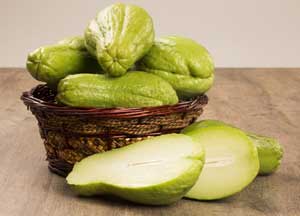




Choko -
F

1. Choko Facts
2. Types of Choko
3. Nutritional Value of Choko
4. Health Benefits of Choko
2. Types of Choko
3. Nutritional Value of Choko
4. Health Benefits of Choko
Choko Facts
History and Origin
Types of Choko
Types of Choko grown and sold in Australia
Choko Nutritional Value
|
Fruit ” Choko ” ( Nutritional value )
Nutritional value per 100 g Chayote, fruit, cooked, boiled, drained, with salt |
|||||||||||||||||||||||||||||||||||||||||||||||||||||||||||||||||||||||||||||||||||||||||||||||||||||||||||||||||||||||||||||||||||||||||||||||||||||||||||||
|
Weight of Fruit – 1 cup, pieces = 160 g
|
|||||||||||||||||||||||||||||||||||||||||||||||||||||||||||||||||||||||||||||||||||||||||||||||||||||||||||||||||||||||||||||||||||||||||||||||||||||||||||||
|
|||||||||||||||||||||||||||||||||||||||||||||||||||||||||||||||||||||||||||||||||||||||||||||||||||||||||||||||||||||||||||||||||||||||||||||||||||||||||||||

|
Reference Values are based on a 2,000 Calorie Intake, for Adults and Children 4 or More Years of Age. Your daily values may be higher or lower depending on your calorie needs.
|
|
Percentages are roughly approximated using (RDA) Recommended Dietary Allowances for adults. Source: Nutrient Database – USDA (United States Department of Agriculture)
|
|
Reference Values for Nutrition – FDA U.S. Food and Drug Administration
|
Choko Nutritional Value
Choko Health Benefits
Choko

HEALTH
References
|
Nutrient Database – USDA (United States Department of Agriculture)
|
|
Reference Values for Nutrition – FDA U.S. Food and Drug Administration
|
For More Information
Choko (chayote) – From Wikipedia, the free encyclopedia
